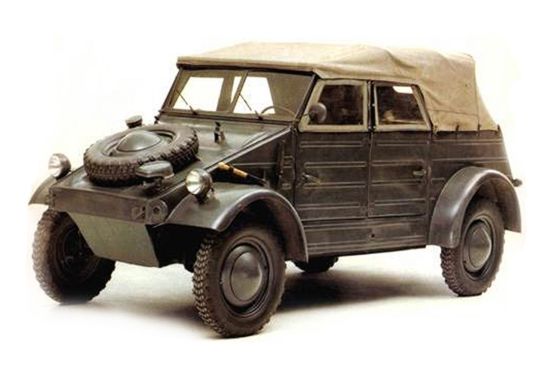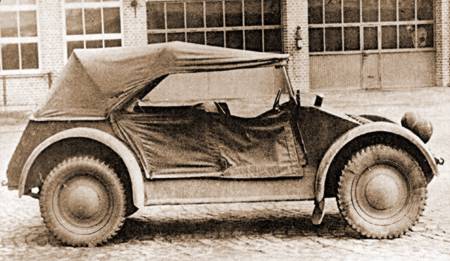Designed by Ferdinand Porsche and built by Volkswagen the Kübelwagen was used by the German Military during World War II. Surprisingly enough, this German version of the Allied Jeep was based heavily on the Volkswagen Type I (what we know today as the Beetle) another of Ferdinand Porsche’s legendary designs.

The initial concept for the Kübelwagen (literally translated to mean “bucket-seat car”) was proposed by none other than Adolph Hitler himself in a 1934 discussion with Porsche about the possibility of a military application for the aforementioned Volkswagen. However, the project did not formally move forward until 1938. At that time Ferdinand was approached by high ranking officers to design an inexpensive, lightweight vehicle that could transport four fully equipped soldiers over rough and rugged terrain.

Originally developed as the Type 62, the first prototype was showcased in November of 1938. Given the transports light weight (715kg or 1578lbs) and self-locking ZF differential the vehicle faired extremely well in rough terrain despite its lack of four-wheel drive.
Porsche Designed Kübelwagen Performs Better Than Expected
Initial field testing in 1939 proved the Porsche designed Kübelwagen to be a competent and reliable aid in the field. However, certain key modifications were requested prior to the beginning of full-scale production in 1940. These included a reduction in the lowest speed possible (so the transport could keep pace with marching troops) and an increase in off-road capabilities. Off-road prowess was complemented by the introduction of new axles, 16 inch wheels, and a limited slip differential. These key items, combined with many other small improvements, completed the build and resulted in full-scale production of the now renamed Type 82 beginning in February of 1940.
From 1940 to 1945 over 50,000 Kubelwagens were produced. While there were other slight modifications made over the five year production run, the basic concept and build quality remained true to Ferdinand Porsche’s original design. Most important to the Kubelwagen’s success was its efficient and reliable air-cooled engine (typical Porsche) and more surprisingly, its smooth, flat underbody allowed the transport to outperform all the competition in snow and ice by acting as a motorized sled and propelling forward when the wheels would sink into mud, snow, ice or sand.
Concept and Quality Remain True to Original Porsche Design
Over 60 years later it is not uncommon to see an original Kübelwagen still being driven or shown by the enthusiasts that enjoy the model. In addition, the Type 82 was the inspiration for the instantly recognizable VW “Thing” (“Trekker” in the UK and “Safari” in Mexico). So, like most things Porsche, it seems even those items designed with a utilitarian purpose in mind are still classic and timeless in certain circles.
Other Porsche Blog Posts You Will Enjoy
Porsche Classic Introduces 2 Motor Oils For Air-Cooled Porsches
Behind the Scenes of Porsche Classic
Why Porsche Should Revive the Front Engine Sports Coupe
[Source: Wikipedia, RetroThing, InterMeccanica]